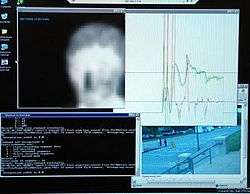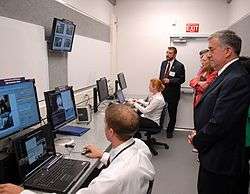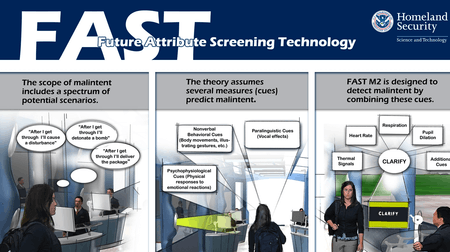Future Attribute Screening Technology
Future Attribute Screening Technology (FAST)[1] is a program created by the Department of Homeland Security. It was originally titled Project Hostile Intent. The purpose is to detect "Mal Intent" by screening people for "psychological and physiological indicators"[2] in a "Mobile Screening Laboratory".[3]

Background


The program was under the Homeland Security Advanced Research Agency and the Science & Technology Human Factors Behavior Science Division of DHS.[4] In a meeting held on July 24, 2008 the DHS Under Secretary Jay Cohen stated, the goal is to create a new technology that would be working in real time as opposed to after a crime is already committed.[5]
The DHS science spokesman John Verrico stated in September 2008 that preliminary testing had demonstrated 78% accuracy on mal-intent detection and 80% on deception.[6] However, this was not a controlled, double-blind study, and researchers from Lawrence University and the Federation of American Scientists have questioned its validity without further evidence.[7]
The system measures pulse rate, skin temperature, breathing, facial expression, body movement, pupil dilation, and other "psycho physiological/behavioral patterns" to stop "unknown terrorists". The technology would mostly be used at airports, borders, and special events.[8] Fox News reported that the mobile units transmit data to analysts, who use "a system to recognize, define and measure seven primary emotions and emotional cues that are reflected in contractions of facial muscles." The system is named MALINTENT. Results are transmitted back to screeners.[4][9]
DHS produced a 'privacy impact assessment' in 2008. It described the system as comprising:[10]
- A remote cardiovascular and respiratory sensor to measure heart rate and respiration
- A remote eye tracker
- Thermal cameras that provide information on the temperature of the skin in the face
- A high resolution video for looking at facial expressions and body movements
- Audio system for analyzing changes in voice pitch
- Possibly other sensors, perhaps pheromone detection
- Anonymized aggregate results of the scanned information
The DHS plan on using cameras and sensors to measure and track the changes in a person's body language, the tone of their voice and the rhythm of their speech. Civil Liberties Groups raised privacy concerns about the project but Burns from the DHS claims "the technology would erase data after each screening, and no personal information would be used to identify subjects, create files, or make lists". He reassured the public that regulations would be put in place to protect privacy if and when the technology is deployed.
Organizations involved
Controversy
Other researchers, such as Tom Ormerod of the Investigative Expertise Unit at the UK's Lancaster University, argue that ordinary travel anxieties could cause false positives—Ormerod told Nature "even having an iris scan or fingerprint read at immigration is enough to raise the heart rate of most legitimate travellers".[7] Others noted that the basic premise may be flawed. Steven Aftergood, a senior research analyst at the Federation of American Scientists, stated "I believe that the premise of this approach—that there is an identifiable physiological signature uniquely associated with malicious intent—is mistaken. To my knowledge, it has not been demonstrated." The Nature article in which he was quoted went on to note that Altergood is concerned that the technology "will produce a large proportion of false positives, frequently tagging innocent people as potential terrorists and making the system unworkable in a busy airport."[7]
Due to the ability of the system to 'read people's thoughts', it is potentially in violation of privacy laws such as the Fourth and Fifth Amendment to the United States Constitution. A summary of the scientific and legal issues with the program was presented at DEF CON in 2011 by independent security researchers.[14]
See also
References
- "'Pre-crime' detector shows promised". newscientist.com. September 23, 2008. Archived from the original on 2009-03-05.
- "HI-TECH WAR ON TERROR". National Geographic, Photo section #6. Archived from the original on April 12, 2011. Retrieved September 21, 2011.
- Office of Procurement Operations Science and Technology (S&T) Stakeholders Conference, January 14, 2008, Defense Technical Information Center, retr May 2011
- Updated: DHS Mobile Screening Experiment Arouses Fears, "Mind reading" capabilities "a bit of an overstatement." David Silverberg 09/25/2008, HS Today, retr May 2011
- "dhs.gov" (PDF).
- "Future Attribute Screening Technologies Precrime Detector: Science Fiction in the News". www.technovelgy.com.
- Sharon Weinberger. "Terrorist 'pre-crime' detector field tested in United States". May 27, 2011, nature.com, retr June 2011
- "Draper Labs awarded $2.6 million contract by DHS". securityinfowatch.com. Archived from the original on September 28, 2011. Retrieved September 21, 2011.
- z Homeland Security Detects Terrorist Threats by Reading Your Mind, Allison Barrie, September 23, 2008, retr May 2011
- DHS. "Privacy Impact Assessment for the Future Attribute Screening Technology (FAST) Project" (PDF). December 15, 2008, dhs.gov, retr May 2011
- Batelle Annual Report 2008 pg 9, retr May 2011
-
"Battelle Memorial Institute Department of Homeland Security Contract # HSHQDC07C00087". input.com. September 2007. Retrieved May 2011. Check date values in:
|accessdate=(help) - Future Attribute Screening Technology (FAST) Demonstration Laboratory - HSARPA BAA07-03A, 2007/09/21, retr May 2011
- "DEF CON 19 Speakers". DEF CON. Retrieved 2011-11-12.
External links
- DHS project site
- DHS public relations video on FAST, vimeo.com, retrieved May 2011